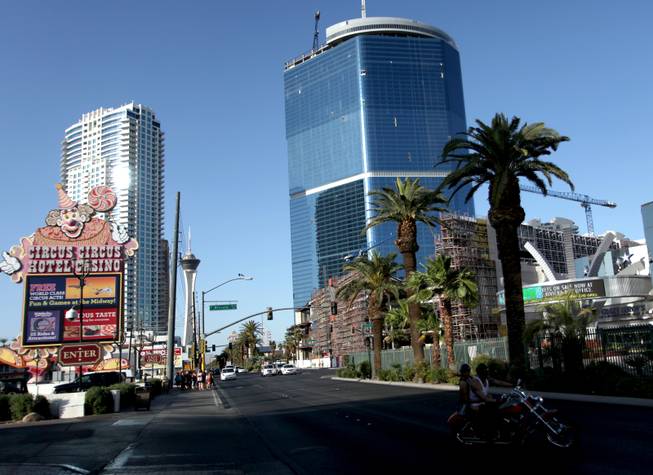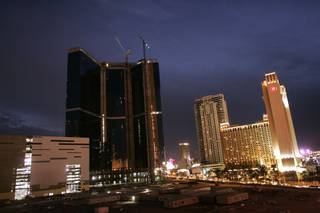
Fontainebleau Resort on the north end of the Las Vegas Strip is shown under construction.
Sunday, June 28, 2009 | 2 a.m.
Sun Archives
Sun Coverage
Las Vegas has a way of building high-rise resorts unlike any other city in the nation.
It builds them in a hurry.
So quickly, in fact, that it’s not unusual for construction to begin before all the architectural plans and details are in place. The goal is to open resorts as quickly as possible so they can start making money.
What might take four or five years to build elsewhere can be built in three years here.
But speedy construction comes with consequences.
The quickened pace has been a contributing factor in construction deaths and injuries at CityCenter, a Sun investigation found last year.
And there’s a financial consequence to building fast, too: Modifications to under-way buildings necessitated by design errors result in change orders, more expenditures — and the need for more money from lenders.
The strategy has served Las Vegas well for years because there was always more money to accommodate the changes. Bank credit was easy. Money flowed.
It’s a different world now. And that helps explain the bankruptcy court filing by the Fontainebleau resort, the second-largest construction project in Las Vegas and one of three major resort sites being developed on the Strip.
When Fontainebleau’s lenders pulled more than $600 million in prearranged financing needed to complete the project, it exposed the strategy of how big resorts are built in Las Vegas — quickly, and with a wink between owners and lenders that more money probably will be needed, so please keep the wallet handy.
Industry executives say that doesn’t occur in other cities, but it has become acceptable here.
“As projects have gotten bigger and fancier and more expensive, everyone jumped on the bandwagon and got paid,” said one insider involved in Fontainebleau, who requested anonymity. “Then we went into this recession.”
And now the practice is no longer indulged.
• • •
Construction of the 3,815-room Fontainebleau Las Vegas began in late 2006 when the economy was still strong.
Builders and lenders knew the risks attached to fast-track building, according to executives, consultants and engineers involved in the construction of the resort. They asked for anonymity because they are still involved in the project, which is now the focus of litigation.
The reasons for participating in a fast-track project are specific to the Las Vegas-style resort industry. Casinos are financed with so much debt that monthly interest expenses run in the millions of dollars. Unlike many industries, gaming can justify it because casinos can generate tens of millions of dollars in revenue each month at significant profit margins. Consequently, casino developers want to open their properties as soon as possible to start paying off the debt and are willing to risk bungling a few details in their rush.
The added cost of fixing design errors — common in complex construction jobs and more so on fast-tracked projects — is justified by the greater cost of carrying a full debt load months after a resort’s projected opening date.
“The opening date never moved. We always threw more money at it. You just have people work overtime to fix problems,” said one engineer, who requested anonymity. “We were building, redesigning, tearing stuff out and starting again.”
Like most Las Vegas resorts built in the past several years, Fontainebleau began construction before final designs for major building elements, such as mechanical systems were available. More than two years into construction, with the property roughly 70 percent complete, final designs for some parts of the building aren’t finished, insiders say.
This process is well known to a group of construction and design specialists whose credits include many of the Strip resorts developed in recent years.
This method allows contractors to begin work based on preliminary drawings for a particular space — a best guess on what goes where. The drawback is in learning that work such as plumbing or wiring is only 80 percent compatible with the final design. Contractors jump around to different parts of the building, in various stages of completion, as designs become available, and fix what doesn’t fit.
“We were building on the edge, where you race out there as far as you can get and build as much as you can with the least amount of information available, knowing full well we’ll have to tear some of it down in six to eight weeks because the designers haven’t caught up to us yet,” the engineer said.
Discrepancies between initial plans and final ones are common when contractors aren’t working off detailed plans.
In one instance at Fontainebleau, air-handling ductwork above the casino interfered with plunge pools planned for the spa on the floor above, which had not yet been designed. The ductwork was moved to make room for the pools. Also, contractors had to reinforce steel and redesign mechanical systems in the convention center to accommodate rigging for signs — an oversight noticed by a convention manager who was hired more than a year after construction began.
“We had more than 12 hours of meetings a week. And invariably, what would happen is, (the general contractor) would say, ‘We want to work in the East Casino’ and the wall guy says, ‘That’s great, but I have no drawings telling me where the walls are,’ ” the engineer said. “Or we would get to an open space and they would say, ‘We haven’t figured that out yet.’ ”
Developers made sure “nobody was sitting around” and were “doing the best they could do the fastest way they could do it,” he said. Along the way, he said, there were meetings with “lots of yelling and screaming.”
Cost overruns aren’t unusual but are typically covered by money set aside for contingencies, said Eric Gelb, a former Citibank construction financier who now runs a consulting firm, Connectors Capital Advisors in Armonk, N.Y.
Bank of America may not have done enough homework to determine whether the financing package was sufficient, he added.
“The question is, did they do their due diligence? Or were they led to believe that they had final specs when they didn’t?” Gelb said.
To account for design changes and factors beyond the developer’s control, such as increases in the cost of labor or materials, construction projects typically set aside 20 percent of the original budget for contingencies. But in the modern resort era in Las Vegas, frequent design changes, errors and scope changes as a result of fast-tracking have resulted in costs drastically higher than the normal contingency budget can cover. The under-construction CityCenter, Cosmopolitan and Fontainebleau projects have each reported a budget increase of more than $1 billion.
The initial $1.5 billion budget of the Fontainebleau, like other major Las Vegas resorts, is like “the first bet in a poker game,” according to one executive, who requested anonymity. It has since grown to $2.9 billion.
Another contributor to Fontainebleau’s rising costs: Designs for the casino, hotel rooms and other major elements of the resort were redone multiple times, sometimes as new firms were brought in to improve on early designs that were shot down, insiders say.
“Fontainebleau was an undisciplined manager of the process,” the executive said. “We threw away lots of designs worth tens of millions of dollars.”
Lenders including Bank of America — the agent bank that arranged financing for Fontainebleau and a major lender to the Las Vegas casino industry — would have been familiar with the fast-track construction process in Las Vegas and resulting cost overruns.
Banks typically hire consultants to comb through construction budgets to make sure financing is enough to cover actual costs.
Fast-tracking and construction consultants are “pretty typical of large projects,” said Shirley Norton, a spokeswoman for Bank of America. Norton declined further comment on the construction process, citing Fontainebleau’s federal lawsuit against Bank of America and other banks for failure to fund the project. A Miami bankruptcy judge has ordered the parties into mediation.
In its lawsuit, Fontainebleau has accused lenders of inventing a bogus reason to back out of a loan they no longer want to fund.
Bank of America claims the loan was in default before the Fontainebleau resort’s filing for bankruptcy protection because of cost overruns. According to court filings, Bank of America says it learned of increases in the budget after the fact, in violation of the loan agreement.
Discrepancies between cost estimates and final costs — well-documented by accountants and consultants — are common on big construction jobs.
Bank of America cites one such discrepancy in court filings, stating that Fontainebleau in April claimed $186.9 million in additional costs had cropped up in a month’s time.
It appears to be the straw that broke the bank’s back. Six days later, on April 20, the banks notified Fontainebleau by letter that the project was “in default” and that they were terminating the loan. (Fontainebleau claims cost overruns themselves don’t give banks the right to terminate the loan and that developers may seek money elsewhere to fill the gap. The banks suggest that Fontainebleau violated loan terms by hiding pertinent facts about cost overruns.)
“While there are a number of factors that can affect the timing and cost of a major construction project, especially one as large and ambitious as Fontainebleau, we do not believe that either fast-tracking or any cost-related issues gave Fontainebleau’s revolver lenders an ‘opening’ or a justification not to fund their commitments,” said Howard Karawan, who is overseeing the project in bankruptcy as Fontainebleau Las Vegas’ Chief Restructuring Officer. “The only reason for the revolver lenders’ refusal to fund was their calculated breach of their obligations, as set forth in Fontainebleau’s complaint.”
Discrepancies have always been problematic but weren’t deal-breakers when business was booming in Las Vegas. There was money to cover them. But financing has since dried up.
An executive caught in the middle of this, who did not want to be named, said “We didn’t think there was enough money to cover construction from Day One,” given the level of luxury planned for the Fontainebleau. “I think the banks were slow to figure that out.”
Indeed, in costing out a project, some educated guesses are made — and some, not so educated. In the locker room world of construction, they are more commonly called WAGs, for Wild Ass Guess.


Join the Discussion:
Check this out for a full explanation of our conversion to the LiveFyre commenting system and instructions on how to sign up for an account.
Full comments policy